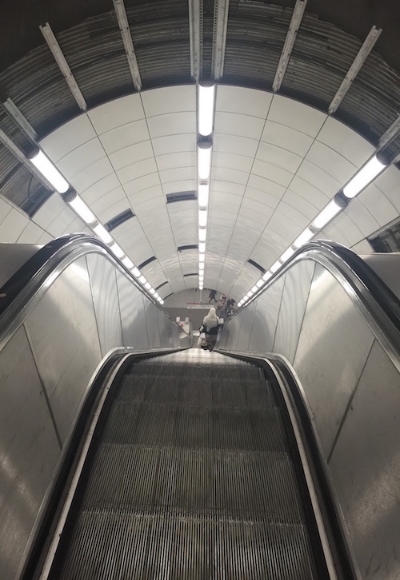EXPLORING THE TUBE AS A TOURIST ATTRACTION
Without question there are a crazy amount of things to see and do in London. It has been said that if one is bored in London, one is bored of life. The city is huge and spread out. My favourite way to see London is to walk it. It’s a fabulous walking city. But walking will only get you so far. Eventually one needs to venture downward into the massive world of the London underground or more affectionately known as "The Tube".
Bank Station then and now. Source The London Transport Museum.
There are some fascinating (and creepy) things you should know about the world’s oldest subway system. In of itself there is so much history, art and design one could deem it as its own tourist attraction. In fact I found this so interesting that originally the Tube was just going to be a smaller part of a "Getting Around London" blog but due to the incredible depth (yes...pun intended) of the Tube and its history I have given it its own story. So here are some of the facts and myths that I personally found very interesting (and disturbing) about the world's oldest subway system the London Underground we call, The Tube.
The first tube ride was 1863. The Times described it as, “a form of mild torture” which might still stand today, especially if you are travelling in rush hour. It officially got its nickname "The Tube” in the early 1900’s after now what is called the Central Line was nicknamed “Twopenny Tube” the cost of riding the train.
There are currently 287 stations (only 29 south of the river Thames). They are connected by 249 miles (402K) of tracks, have 426 escalators (longest being 196 feet). It carries over 1.1 billion people annually. The deepest station is Hampstead at 192 ft. (58.5m) below street level, which is approximately 21 stories way, way down. The busiest station at any one time is Waterloo that has an impressive 53,000 people going through that station and that is just in morning rush hour. On a similar comparison Waterloo also reportedly has the largest numbers of mice. More on that a little further down. An average of one person per week commits suicide by jumping and London For Transport has given a nickname to the jumpers as, "one-under". Apparently the time preferred by most "one-under's" is 11:00AM (I think they must have wanted to avoid morning rush hour at Waterloo). Each year each tube train travels 114,500 miles and the average speed is 20.5MPH. Only 45% of the network is actually in tunnels.
To date, only three babies have been born on the Tube. To me, considering the volume of people riding each year, then multiply that by over 150 years I would have thought the numbers would have been a lot higher. Guess it is not the preferred mode of transport for women in labour. The Tube has been used officially and unofficially as bomb shelters during both world wars. Hundreds of people died not just of bombs exploding, but stampeding, fire, overcrowding and suffocation.
Earlier this week I left my umbrella on the tube which led me to thinking just how many items and what things get left daily? There are an estimated 1,000 items each day that get left on the tube or buses. According to The Independent aside from the obvious umbrellas, electronics, items of clothes, people have left dentures, baby strollers, breast implants and to me the weirdest (yes weirder than breast implants) were the ash remains of Thomas Frederick Johnson who had died in 1994. To the best of my knowledge Mr. Johnson is still waiting to be claimed at Transport For London's (TFL) lost property vault on Baker Street. Is no one looking for this man? Maybe his dying wish was his remains be left somewhere on the Central Line?
Paul Cowan holds up the box containing the ashes of Thomas Frederick Johnston. Source London Live.
Are you kidding me????
Here is something I wish I didn’t know as I have a huge phobia of all things rodent, an estimated half a million mice are living in the underground. Just how do they know this?? Do they do a rodent head-count? Also another disturbing tidbit is that there are mosquitoes that live in the tube tunnels that have evolved and mutated into a unique species not found anywhere else in the world and are known for its voracious biting. Kinda makes you want to take an Uber.
Actor William Terriss whose ghost haunts Covent Garden Station.
Of course you can’t have a history of over a 150 years in London and not have its share of ghost stories. It has been said that several of the stations are haunted. Two of the infamous hauntings are the ghost of Anne Naylor aka “Screaming Spectre” a young milliner who was tortured and died in 1758 at the hand of her employer who haunts Farringdon Station and actor William Terriss who haunts Covent Garden Station. It has been documented and actually recorded (so says Google) that in the Farringdon Station one can hear a blood-curdling scream just after the last train leaves. I myself have not checked this out but with my macabre imagination I know I will eventually get there. Locals believe it to be the ghost of Anne Naylor. Mr. William Terriss was one of England’s most popular actors in the 1880’s famous for his swashbuckling leading man roles and his many leads in Shakespearean plays. In 1897 he was stabbed to death by a deranged (and can I guess unemployed?) actor at the stage door of the Adelphi Theatre, where Terriss was performing. This murder was the talk of London and his killer was sentenced to life in an insane asylum. Some believed that was way too lenient a sentence and that his killer should have put to death. I guessed the judge believed it was a totally appropriate sentence for an actor. Terriss’ ghost has been seen numerous times over the years haunting not only the station but also the Adelphi theatre where he was killed. There are some staff that refuse to work at both stations because of this.
On the lighter side of the "Tube News" in 1909 Selfridge’s department store (LOVE) unsuccessfully lobbied to get Bond Street station renamed after the store. This fact I have found more interesting after having watched Jeremy Piven in the television series, Mr. Selfridge. In 2005 the London Underground announced that in looking to help curtail youth vandalism it would play loud classical music in their stations that had problems with loitering youths. Problems dropped by 33%. I wonder if that will work at home?
Dozen of famous architects designed various stations where it was considered a great honour to get such a commission. There is a war memorial at Baker Street commemorating those tube employees killed in WWl. Scottish sculptor Eduardo Paolozzi designed the mosaic mural for Tottenham Court Station. Is it just me or does that name Eduardo Paolozzi not scream Scottish?
Tottenham Court Station. Mosaic mural by Eduardo Paolozzi
2006 The London Underground Map came in second in a BBC design competition for the public’s Favourite Design of The 20th Century. First, if you were wondering was The Concorde, voted number one design. Just goes to show that being number one doesn’t mean you will still be standing (or flying) 150 years later.
Finally, as there is no real way for me to cover the vastness of everything TUBE all I can say is even if you are using it as it was intended to be, a mass transportation system, look around. You are surrounded by British history, art and likely even a few ghosts. And if that is good enough for Queen Elizabeth II the first reigning Monarch to take the tube that is good enough for me.












